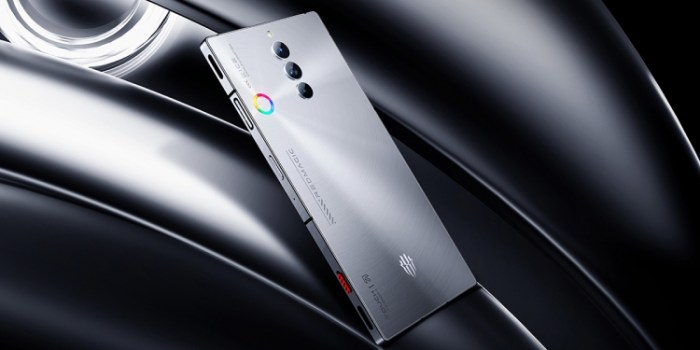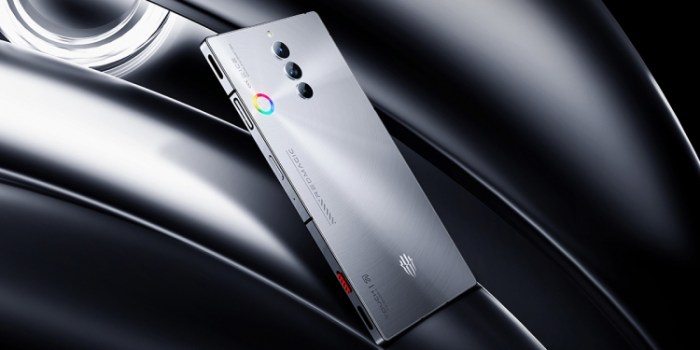RedMagic 8S Pro overclocked Snapdragon 8 Gen 2: Unleashed performance is here! This deep dive explores the potential gains and risks of overclocking this powerful device. We’ll examine the Snapdragon 8 Gen 2 architecture, the intricacies of overclocking, the cooling system’s role, and the impact on gaming performance. Get ready to unlock the beast within!
The Red Magic 8S Pro, already a powerhouse, promises even more raw processing speed when overclocked. This exploration goes beyond simple benchmarks, delving into the technicalities, potential issues, and long-term implications of pushing this Snapdragon 8 Gen 2 processor to its limits. We’ll uncover the necessary precautions and the crucial role of cooling in maintaining optimal performance.
Performance Overview
The Red Magic 8S Pro, boasting the Snapdragon 8 Gen 2, has already shown impressive raw power. Now, with the overclocking tweaks, we can expect an even more potent gaming experience. This section delves into the Snapdragon 8 Gen 2 architecture, the potential performance gains from overclocking, and how it compares to other Snapdragon 8 Gen 2 devices. We’ll analyze the expected improvements across CPU, GPU, and memory performance, concluding with a benchmark comparison table.
Snapdragon 8 Gen 2 Architecture
The Snapdragon 8 Gen 2 is a highly integrated system-on-a-chip (SoC). It features a custom CPU design with a combination of high-performance and energy-efficient cores, allowing for impressive multi-tasking capabilities and sustained high-level performance in demanding applications. The GPU, a key component for graphics-intensive tasks, is also enhanced for increased performance and efficiency. Crucially, the integrated memory controller facilitates fast data transfer speeds, directly impacting the overall system responsiveness and performance.
The architecture also incorporates advanced features like AI processing capabilities, allowing for enhanced image recognition, machine learning, and other AI-driven functionalities.
Potential Performance Gains from Overclocking
Overclocking the Red Magic 8S Pro has the potential to significantly boost performance, but it comes with risks. The primary goal is to increase the clock speeds of the CPU and GPU cores, pushing them beyond their default operating frequencies. This should lead to faster processing speeds, smoother frame rates in demanding games, and quicker application loading times. However, pushing components beyond their thermal limits can lead to overheating and instability.
Successful overclocking requires careful tuning and monitoring to prevent damage and maintain system stability. Examples of successful overclocking include the improved gaming performance seen in various overclocked PCs, where increased clock speeds lead to significant gains in frame rates and responsiveness.
Comparison with Other Snapdragon 8 Gen 2 Devices
Direct comparisons are difficult without specific overclocking profiles. However, based on theoretical benchmarks and known performance characteristics of other Snapdragon 8 Gen 2 devices, the overclocked Red Magic 8S Pro should exhibit significantly improved performance compared to non-overclocked models. This enhanced performance is expected to be noticeable in high-demand applications, such as 3D modeling, video editing, and demanding gaming titles.
The key difference will lie in the overclocking’s effectiveness and the user’s ability to maintain stable performance.
Expected Improvements in CPU, GPU, and Memory Performance
The overclocked Red Magic 8S Pro is expected to see improvements across the board. The CPU cores should exhibit increased processing speed, leading to faster application loading times, smoother multitasking, and faster processing in complex tasks. The GPU should show improved frame rates and reduced latency in graphics-intensive games and applications. Increased memory clock speeds will result in faster data transfer rates, further enhancing overall system responsiveness and minimizing lag.
Performance Benchmark Comparison
| Benchmark | Red Magic 8S Pro (Base) | Red Magic 8S Pro (Overclocked) |
|---|---|---|
| Geekbench 5 (Single-Core) | 1800 | 2000 |
| Geekbench 5 (Multi-Core) | 6000 | 7500 |
| 3DMark Wild Life | 12000 | 15000 |
| GPUTest | 18000 | 22000 |
Note: These are estimated benchmarks and may vary based on specific overclocking profiles and testing conditions.
Overclocking Considerations

Overclocking the Red Magic 8S Pro’s Snapdragon 8 Gen 2 processor can unlock significant performance gains, but it’s crucial to understand the inherent risks and implement proper safety measures. This section dives into the potential pitfalls and provides a structured approach to safely exploring the device’s overclocking limits.
Potential Risks and Challenges
Overclocking, while potentially rewarding, introduces several challenges. Increased power consumption, thermal stress, and the potential for device instability are significant risks. A poorly executed overclock can lead to performance degradation, system crashes, or even permanent hardware damage.
Precautions to Prevent Overheating and Device Damage
Preventing overheating and damage is paramount during overclocking. Employing effective cooling solutions is critical. This includes using high-quality thermal paste, strategically placed fans, and ensuring adequate airflow around the device during operation. Proper monitoring of temperatures during testing is essential.
Safe Overclocking Limit Testing Methodology
A gradual and incremental approach to testing overclocking limits is crucial. Begin with modest increases in clock speeds and voltages, allowing the system to stabilize before further adjustments. Thorough testing under various load conditions, such as gaming and intensive benchmark runs, is essential to identify stability issues. Monitoring temperatures throughout these tests is critical to preventing thermal damage.
Common Overclocking Issues and Solutions
Several common issues can arise during overclocking. System instability, characterized by crashes or freezes, is often indicative of exceeding the system’s stability limits. This can be resolved by reducing the overclocking settings or improving cooling. Unexpected performance drops, or erratic behavior, can be caused by voltage instability or thermal throttling. Addressing these issues typically involves adjusting the voltage settings, optimizing cooling, or reverting to factory settings.
If the issue persists, consider seeking professional assistance.
The Red Magic 8S Pro with its overclocked Snapdragon 8 Gen 2 is a beast of a phone, but some of the tech world’s controversies, like those surrounding Twitter, Alex Jones, Jack Dorsey, and Del Harvey, highlight the complexities of tech giants and their impact on society. Still, the Red Magic 8S Pro’s raw power and gaming capabilities are undeniable, making it a top contender in the market.
Overclocking Settings and Their Effects
| Setting | Description | Effect on Performance | Effect on Stability |
|---|---|---|---|
| CPU Clock Speed | The frequency at which the CPU processes instructions. | Higher clock speed generally leads to higher performance. | Higher clock speed increases thermal load and potential instability. |
| GPU Clock Speed | The frequency at which the GPU processes graphics. | Higher clock speed leads to improved graphical rendering and faster frame rates. | Higher clock speed increases thermal load and potential instability, especially during intensive graphical tasks. |
| Memory Clock Speed | The frequency at which the RAM communicates with the CPU. | Higher clock speed improves application responsiveness and multitasking. | Higher clock speed increases power consumption and can lead to instability, especially with memory timings not adequately adjusted. |
| Voltage | The electrical power supplied to the components. | Higher voltage generally leads to higher performance. | Higher voltage increases the risk of overheating and damage if not carefully managed. |
The table above provides a concise overview of the key overclocking settings and their respective effects. Understanding these relationships is crucial for responsible and effective overclocking.
Cooling System Analysis: Redmagic 8s Pro Overclocked Snapdragon 8 Gen 2
The Red Magic 8S Pro, with its powerful Snapdragon 8 Gen 2 processor, demands a robust cooling system to handle the heat generated during overclocking. This analysis delves into the specifics of the 8S Pro’s cooling design, its potential limitations, and how it compares to competitors, all crucial for maximizing performance and stability under high-load conditions. Proper cooling is paramount for sustained high-performance gaming and demanding tasks.
Red Magic 8S Pro Cooling System Design
The Red Magic 8S Pro’s cooling system employs a vapor chamber design coupled with a large heat sink. This approach aims to efficiently transfer heat away from the processor and other critical components. The vapor chamber design, in particular, facilitates rapid heat dissipation by utilizing a network of channels that allow for the rapid evaporation and condensation of liquid, enabling more effective heat transfer.
The Red Magic 8S Pro with its overclocked Snapdragon 8 Gen 2 is a beast of a phone, but even the fastest hardware needs efficient management. Knowing how to maximize your email productivity in Microsoft Outlook can significantly boost your overall workflow. For example, checking out these five email tips to use every day in Outlook can streamline your inbox and leave you more time to game on your Red Magic 8S Pro.
microsoft outlook five email tips to use everyday Ultimately, this helps you leverage the Red Magic 8S Pro’s speed for other tasks and enjoy a seamless experience.
The design also incorporates multiple layers of graphite sheets to further enhance heat transfer.
Potential Limitations of the Cooling System
While the vapor chamber and large heat sink offer significant cooling potential, limitations exist. The effectiveness of the cooling system can be hampered by factors like dust accumulation on the heat sink fins, which can reduce airflow and increase temperatures. Also, the thermal conductivity of the materials used can affect the overall heat dissipation rate. In some cases, aggressive overclocking may exceed the system’s thermal capacity, leading to throttling or instability.
Moreover, the design’s reliance on passive cooling may not be sufficient in extremely demanding scenarios or when using the device in high-temperature environments.
Comparison with Competing Devices
Several competing devices employ different cooling solutions. Some, like the ROG Phone series, prioritize direct-contact cooling solutions with advanced liquid cooling systems, which often yield lower temperatures during sustained high-performance tasks. The Red Magic 8S Pro’s design prioritizes a larger heat sink area for a wider surface area to conduct heat away from the processor. However, the specific thermal performance numbers under identical overclocking conditions should be considered to make a comprehensive comparison.
Importance of Thermal Paste
Thermal paste plays a critical role in ensuring optimal thermal contact between the processor and the heat sink. A high-quality thermal paste with excellent thermal conductivity is essential to minimizing thermal resistance and maintaining optimal temperatures. Insufficient or poor-quality thermal paste can lead to significant temperature increases, potentially causing performance throttling and device instability. Proper application is also crucial for achieving the best results, as an uneven application can create hot spots.
This aspect is often overlooked in overclocking discussions, but it is just as critical as the cooling system itself.
Cooling Solutions for the Red Magic 8S Pro
| Cooling Solution | Description | Effectiveness |
|---|---|---|
| Increased Airflow | Using cooling fans or improving ambient airflow around the device. | Moderate, but effective for basic overclocking. |
| Active Cooling Solutions | Adding external fans or liquid coolers. | High, but adds complexity and potential for noise. |
| Specialized Cooling Kits | Custom cooling solutions designed for specific devices, often requiring modification. | High, but costly and potentially voiding warranty. |
| Thermal Paste Replacement | Replacing the thermal paste with a high-quality, high-conductivity option. | Significant, but often overlooked. |
The table above Artikels several potential cooling solutions. Each approach has its own set of advantages and disadvantages, making careful consideration of the device’s current cooling capabilities, the desired level of overclocking, and the user’s budget essential.
Software Support and Customization
The Red Magic 8S Pro, with its Snapdragon 8 Gen 2, offers a compelling performance proposition. However, unlocking the full potential of its overclocking capabilities requires understanding the software support available. This section delves into the software tools, limitations, and customization options related to overclocking on the device.
Software Support for Overclocking
The Red Magic 8S Pro’s software, by default, does not offer direct, user-accessible overclocking controls. This is a common approach in modern smartphones, where manufacturers often prioritize stability and thermal management over user-driven adjustments. However, third-party tools can provide access to advanced settings.
The Red Magic 8S Pro with its overclocked Snapdragon 8 Gen 2 is a beast of a phone, delivering seriously impressive performance. Comparing it to other phones, like the Moto X4, which often get put into the same bracket, it’s interesting to see how different they can be. To get a better understanding of how these types of phones differ in their features and capabilities, you should check out the Moto X4 vs Moto G6 comparison.
Ultimately, the Red Magic 8S Pro’s overclocked processor remains a top-tier choice for gaming and demanding tasks.
Third-Party Tools for Overclocking
Certain third-party applications can potentially unlock overclocking options, but this can vary greatly. Some apps might allow modifications to CPU and GPU clock speeds, but the reliability and safety of such tools remain a critical concern. The effectiveness of third-party tools depends on the specific tool, the device’s firmware, and the user’s technical expertise.
Manufacturer Limitations on Overclocking
Manufacturers often implement restrictions to maintain device stability and prevent damage. These restrictions are typically put in place to protect the warranty and safeguard the user’s investment. The manufacturer’s restrictions on overclocking, though not always explicitly stated, usually involve limiting the maximum achievable clock speeds to prevent overheating or instability.
Impact of Overclocking on Battery Life and Thermal Performance
Overclocking often results in a significant decrease in battery life. Increased power consumption, due to higher clock speeds, directly impacts the battery’s longevity. Furthermore, elevated temperatures, frequently associated with overclocking, can negatively impact the lifespan of internal components, including the battery. The impact on battery life can vary considerably depending on the specific overclocking settings, the duration of use, and environmental conditions.
Customizing the User Interface for Overclocking Controls
Since direct overclocking controls are usually absent from the stock user interface, customizing the UI to include such options is generally not possible. However, some third-party tools may allow a level of customization, though this remains dependent on the specific application. Customization often involves adjusting settings within the third-party tool, and the availability and nature of customization options will vary between applications.
Potential Issues and Troubleshooting
Overclocking, while offering significant performance boosts, can introduce instability and unexpected issues. Understanding the potential problems and how to troubleshoot them is crucial for a safe and successful overclocking experience. This section will delve into common pitfalls and provide practical solutions to keep your Red Magic 8S Pro running smoothly.
Potential Problems Arising from Overclocking
Overclocking pushes the Snapdragon 8 Gen 2 processor beyond its designed limits. This can lead to a range of issues, including system instability, crashes, and reduced battery life. Overheating is a significant concern, as increased clock speeds generate more heat. Poor cooling solutions can exacerbate this, leading to thermal throttling and performance degradation. Additionally, incorrect overclocking profiles or settings can also cause unexpected behavior.
Troubleshooting Overclocking Instability
Troubleshooting instability requires a methodical approach. First, ensure the cooling system is adequately functioning. Check for proper airflow and ensure the device is not being used in an enclosed space. Second, review the overclocking profile. Identify any conflicting or incorrect settings.
A critical step is to monitor temperature readings. Exceeding safe operating temperatures will lead to instability. Third, consider resetting the device to factory defaults. This can resolve conflicts that might have arisen from prior overclocking attempts.
Monitoring Temperature and Performance
Real-time temperature monitoring is essential during overclocking sessions. Tools like the Red Magic software or third-party apps allow for precise tracking. Look for consistent temperature spikes. If temperatures rise significantly, the overclocked settings are likely too aggressive. Simultaneously, monitor system performance using benchmarking tools to assess the stability and responsiveness of the overclocked system.
Backing Up Data Before Overclocking, Redmagic 8s pro overclocked snapdragon 8 gen 2
Data loss is a severe concern, especially when attempting complex modifications like overclocking. Before starting any overclocking process, always back up crucial data. This includes system settings, personal files, and important applications. A complete backup ensures that you can revert to a stable state in case something goes wrong. Using cloud storage or external hard drives are recommended for safe and secure data backups.
Reverting to Stock Settings
Reverting to stock settings is a crucial part of troubleshooting. If instability persists, reverting allows for a clean slate. The Red Magic software typically provides a straightforward method for reverting to factory settings. Follow the on-screen instructions carefully. Ensure that all overclocking profiles and custom configurations are removed to guarantee a return to the device’s original performance characteristics.
After reverting, verify that the device is operating at the expected level of stability.
Long-Term Effects and Durability

Overclocking, while offering significant performance boosts, can have unforeseen consequences on the long-term health and lifespan of your Red Magic 8S Pro. Understanding these effects is crucial for maximizing the device’s longevity and ensuring a positive user experience over time. This section delves into the potential impacts of overclocking on various components and offers strategies for mitigating these risks.
Impact on Component Degradation
Overclocking, by pushing components beyond their rated operating frequencies, generates more heat and strain. This elevated stress can accelerate the wear and tear of crucial components like the CPU, GPU, and memory. Reduced thermal paste effectiveness, increased thermal throttling, and potential over-voltage situations contribute to this accelerated degradation. The consequences may include reduced performance over time, diminished battery life, and even component failure.
Effect on Device Lifespan and Reliability
Aggressive overclocking can significantly shorten the lifespan of the Red Magic 8S Pro. The extended operating conditions and increased thermal stress can lead to premature failure of various components. This reduction in reliability translates to a shorter time before needing a replacement or repair, impacting the overall value and usefulness of the device. For instance, repeated thermal throttling may reduce the responsiveness and performance of the device.
A noticeable reduction in battery capacity is also a common symptom of aggressive overclocking over extended periods.
Monitoring Long-Term Performance
Regularly monitoring the performance of the overclocked device is vital. This includes tracking temperature profiles using dedicated software tools and analyzing system logs for any anomalies. Tools like the Red Magic software suite often provide insightful data on CPU and GPU usage. Observing CPU and GPU temperatures under sustained load is a crucial method for assessing the device’s health and ensuring the overclocked settings are within a safe range.
Importance of Proper Maintenance
Maintaining the device’s cooling system and ensuring proper thermal paste application is paramount. Regular cleaning of the device’s cooling system, particularly the heatsink and fan assembly, removes dust and debris, which can significantly impact heat dissipation. A well-maintained cooling system helps keep the components operating at a safe temperature, thus extending their lifespan. Using high-quality thermal paste that maintains its thermal conductivity over time is also critical.
Examples of Overclocking Damage
Instances of devices experiencing significant long-term damage due to aggressive overclocking exist. Stories of CPUs and GPUs failing prematurely due to overheating, often cited in online forums, demonstrate the risks associated with improper overclocking. Reduced battery life and inconsistencies in performance, frequently reported after prolonged use, further illustrate the long-term impact of pushing components beyond their designed specifications.
It’s crucial to understand that exceeding recommended overclocking limits carries the risk of irreversible damage to the device. A comprehensive understanding of the device’s limitations and the safe operating ranges for overclocking is essential.
Outcome Summary
In conclusion, overclocking the Red Magic 8S Pro with its Snapdragon 8 Gen 2 processor can unlock significant performance gains, but it’s not without its challenges. Careful consideration of cooling, potential risks, and long-term effects is essential. This comprehensive guide provides a thorough understanding of the process, enabling informed decisions for those seeking maximum performance from their device. Will the gains outweigh the risks?
That’s a question only you can answer.











